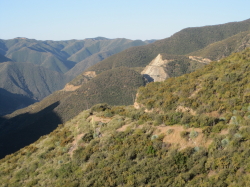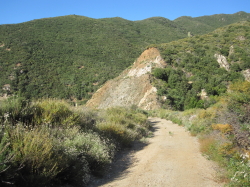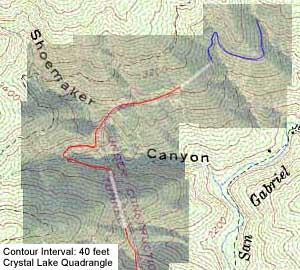| |

 |
| |
 |
| |
 |
| |
 |
| |
 |
| |
 |
| |
 |
| |
 |
| |
 |
| |
 |
| |
Dan's Hiking Pages: Hikes in the San Gabriels and Beyond |
|

|
Shoemaker Canyon Road
AKA The Road to Nowhere, Convict Road,
Armageddon Highway
East Fork San Gabriel River / Angeles National Forest
Southern California
|
Trail Stats
|
|
Mileage (r.t.)
|
5.0
|
|
Trailhead
|
2300'
|
|
Trail end
|
3000'
|
|
El. gain
|
750'
|
|
Gain per mi.
|
300'
|
In contrast to the immensely popular nearby hike to the Bridge to Nowhere, Shoemaker Canyon Road and its Tunnels to Nowhere gets a lot less attention. High on the western slopes of the East Fork San Gabriels River is a 4.5-mile road with two long tunnels that abruptly ends in the rugged mountains.
Shoemaker Canyon Road is the legacy of Cold War nuclear paranoia. Los Angeles, with its many military installations and aerospace companies, was a key target for a Soviet atomic attack. Officials decided Angelinos needed an escape route from the L.A. Basin, so they masterminded a 25-mile road through the heart of the rugged San Gabriels Mountains to the Mojave Desert. Construction began in 1956 and much of the work was done by inmates from the Sheriff's Department detention camps. Finally, after only 4.5 miles of progress cutting into the ridiculously steep mountains, the project was abandoned in 1969 because of budget cuts, opposition by conservationists, and a muting of Cold War paranoia. Quite frankly, the project was a huge boondoggle.
Today, this well-graded dirt road penetrates several miles up the East Fork, on the east-facing slope hundreds of feet above the river. And then it ends. No peak. No waterfall. No campground. The road just stops abruptly in the thick brush on a steep mountainside. I suppose you could name the second tunnel as the destination, since, after emerging from the tunnel, the maintained road ends and there's nothing but bushwhacking through brush and foxtails where the road used to exist for another half mile.
If you skip the bushwhacking after the second tunnel, Shoemaker Canyon Road provides an opportunity for a nice stroll through some rich chaparral with splendid views down into the canyon below and to the eastward high country above: Iron Mountain (8007') looming above, and in the background, Mt. Baldy, Telegraph Peak, Thunder Mt., Timber Mt., Cucamonga Peak, and Sunset Peak.
Season: October through May
This hike is almost entirely in the open with no shade. Avoid hiking this trail in hot weather. On a June day when I hiked Shoemaker Canyon, it was not too hot, but the sun was relentless on the return. Some pleasant breezes helped. Lots of reflective light; wear sun glasses, and of course sun screen. Or hike in the early morning or late afternoon when it's cooler and the surrounding topography provides shade. See Seasons of the San Gabriels for a detailed description of minding the seasons.
Getting to the Trailhead:
 From Interstate 210 in Azusa, take Azusa Avenue (Hwy 39) north about 12 miles to the junction at the East Fork Road (8.6 miles from the forest station at the mouth of the canyon). Turn right (east). Cross the bridge and drive 3.3 miles to Shoemaker Canyon Road on the left. Turn left unto Shoemaker Road and drive 2 miles on the paved road to the locked gate. Park in the parking area. From Interstate 210 in Azusa, take Azusa Avenue (Hwy 39) north about 12 miles to the junction at the East Fork Road (8.6 miles from the forest station at the mouth of the canyon). Turn right (east). Cross the bridge and drive 3.3 miles to Shoemaker Canyon Road on the left. Turn left unto Shoemaker Road and drive 2 miles on the paved road to the locked gate. Park in the parking area.
 Map to trailhead:
Shoemaker Canyon Road
Map to trailhead:
Shoemaker Canyon Road
No Adventure Pass Needed - Previously a National Forest Adventure Pass was required for parking at this trailhead since it is within the Angeles National Forest. As of September 2016, the Recreation Enhancement Act restricts the requirement for an Adventure Pass to only sites that provide designated amenities, such as picnic tables, toilets, and trash receptacles. Visitors do not have to display a recreation pass if they park outside these sites. See here for more Adventure Pass information.
Trail Description:
 Walk past the locked gate and head north up the road. As you walk, occasionally you'll want to scale the berm on the right to get views east down into the canyon. At about 10 minutes there's a flat area on the left just past the large two-sided road cut. In a certain seasons there is a colony of bee hives. At 20 minutes there's a nice view down to Heaton Flat campground. When the campground is in use, you can hear voices of loud campers. Heaton Flat Trail can be seen snaking up the canyon east from the campground. After another 15 minutes you'll arrive at the gully described in the Sierra Club 100 Peaks Section as the route junction for Rattlesnake Peak (see below). Walk past the locked gate and head north up the road. As you walk, occasionally you'll want to scale the berm on the right to get views east down into the canyon. At about 10 minutes there's a flat area on the left just past the large two-sided road cut. In a certain seasons there is a colony of bee hives. At 20 minutes there's a nice view down to Heaton Flat campground. When the campground is in use, you can hear voices of loud campers. Heaton Flat Trail can be seen snaking up the canyon east from the campground. After another 15 minutes you'll arrive at the gully described in the Sierra Club 100 Peaks Section as the route junction for Rattlesnake Peak (see below).
 After 8 minutes from the gully is the entrance to the first tunnel (1.65 miles according to my calculations with Topo! software). The inscription on the keystone is 1961. Painted on the wall just inside on the right is the notation, "Ele. 2785." It takes a good 5 or 6 minutes to walk the length of the tunnel (on hot day, the tunnel's cool shade is a nice reprieve from relentlessly pounding sun outside). After 8 minutes from the gully is the entrance to the first tunnel (1.65 miles according to my calculations with Topo! software). The inscription on the keystone is 1961. Painted on the wall just inside on the right is the notation, "Ele. 2785." It takes a good 5 or 6 minutes to walk the length of the tunnel (on hot day, the tunnel's cool shade is a nice reprieve from relentlessly pounding sun outside).
In about 6 minutes after leaving the tunnel, there's a flat area on the right which hosts more beehives in season (they were there in June but not March). The hum of bees was disconcerting, but I walked safely past with no hassles. Seven minutes past the bees is the entrance to the second tunnel (2.46 miles according to my calculations with Topo!). Painted on wall: "Ele. 2945". This tunnel is shorter than the first, but well over 100 yards in length. On the north end of the tunnel the elevation painted on the wall is 2956.05
Past this second tunnel is where the maintained road ends. Unless you're wearing long pants and prepared for bushwhacking, this is where you'll want to turn around and head home. The last half mile of road past the tunnel is overgrown and harsh and offers little reward except a nice view back south down the canyon. Return the way you came.
Shoemaker Canyon Road is indeed an interesting and historical walk, worth two to three hours on a Saturday morning. 
Mysteries of the Abandoned - Armageddon Highway
 Shoemaker Canyon Road and its tunnels are featured on the Science Chanel's Mysteries of the Abandoned series. The show first aired on Season 2, Episode 1 on March 20, 2018, and is titled "Armageddon Highway." It's the second segment of the three-segment episode. I was listening to the show passively while working on my hiking pages, and the very first words of the segment instantly grabbed my attention: "Over 2,000 miles away, across the Gulf of Mexico, a barren landscape hides an enigmatic enterprise of forgotten engineering. High above Los Angeles is a closed-off road leading 900 feet up in the San Gabriel Mountains. It leads to a mysterious masonry arch over 20 feet high driven into its slopes."
Shoemaker Canyon Road and its tunnels are featured on the Science Chanel's Mysteries of the Abandoned series. The show first aired on Season 2, Episode 1 on March 20, 2018, and is titled "Armageddon Highway." It's the second segment of the three-segment episode. I was listening to the show passively while working on my hiking pages, and the very first words of the segment instantly grabbed my attention: "Over 2,000 miles away, across the Gulf of Mexico, a barren landscape hides an enigmatic enterprise of forgotten engineering. High above Los Angeles is a closed-off road leading 900 feet up in the San Gabriel Mountains. It leads to a mysterious masonry arch over 20 feet high driven into its slopes."
 You can view the episode online (the Shoemaker segment begins at about time counter 12:18):
You can view the episode online (the Shoemaker segment begins at about time counter 12:18):
|

Looking south from a brusy mountainside.
The road-cuts from Shoemaker Canyon Road scar the mountains.
|

Heading south on Shoemaker Canyon Road.
Thick, mature chaparral blankets the terrian.
|
Mileage, Maps, and Elevation:

Upper End of Shoemaker Canyon Road. The red line follows the route based on aerial photos. The blue is the bushwhacking trail for the last half mile beyond the second tunnel. The USGS and Harrison maps do not show the second tunnel, but the tunnel extends a couple under yards past where the maps indicate the road ends. See full topo map (100K). Note differences to USGS topo map.
|
Various maps and trail guides have conflicting one-way mileage in the range of 2.2 to 2.75 miles to the end of the second tunnel. I've calculated 2.46 miles based on GPS and maps, and rounded up to 2.5, thus 5.0 miles round trip.
The elevations conflict in maps and literature too. I've used elevations from the Harrison map of 2300' for the trailhead and 3000' for the end of the second tunnel, which aligns pretty close to my calculation using Topo! software. At the north end of the second tunnel is the inscription 2956.05. My figure of 750 feet elevation gain is based on some roller coaster action.
The USGS topo map shows the road route that was planned rather than that which actually exists. See topo map (100K). The map also shows two roads down to the river, but I saw no such passable routes but did see that there may have been some trails years ago. I do not recommend leaving the road to go down to the river unless you're ready for serious trail blazing through dense brush and steep terrain.
Bottom line, don't worry about the map and exact numbers, just hike up the road for a couple miles until you pass through the second tunnel. If you're prepared for bushwhacking, you can forge on for another half mile. If not, head back. Figure that you've traveled about 5 miles round trip, gaining between 700 to 900 feet, averaging 220 to 360 vertical feet per mile. But more important than these numbers is the temperature. If it's a hot day, a 5-mile hike can feel more like 8 miles.
Rattlesnake Peak junction:
The first section of the Rattlesnake Peak (5826') route is on Shoemaker Canyon Road. The Sierra Club Hundred Peaks Section gives this description: "From the parking area (2300'), pass the gate and hike up the road 1.5 miles to a gully shortly before a deep two-sided road cut. If you can see the entrance to the tunnel you have gone too far."
See my Rattlesnake Peak page.
Related links on Dan's Hiking Pages and Blog:
Links:
Books:
- Afoot and Afield in Los Angeles County - by Jerry Schad (Wilderness Press: Berkley). Area A-13, Trip 6: "Shoemaker Canyon Road." Good trail description with historical background. Puts it at 5.5 miles round trip with 900 feet in elevation gain.
- Los Angeles County: A Day Hiker's Guide - by John McKinney (The Trailmaster, 2006). "Shoemaker Canyon." Good trail description with historical backgrouond. Puts it at 5.5 miles round trip with 800 feet in elevation gain.
Last Hiked: June 27, 2010
|
|